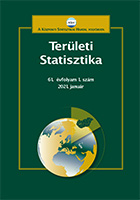Az 5000 főnél népesebb nagyközségek, községek és az ennél kisebb népességű városok európai uniós fejlesztési projektjeinek kvantitatív összehasonlítása
A quantitative comparison of European Union funded development projects of villages with a population over 5,000 inhabitants
with those of towns with a population of less than 5,000 inhabitants
Author(s): György CsomósSubject(s): Social Sciences, Economy, Geography, Regional studies
Published by: Központi Statisztikai Hivatal
Keywords: settlement development; settlement plan; legal status; town; population number
Summary/Abstract: In 2021, Act LXXVIII of 1997 on the De-velopment and Protection of the Built Environment redefined the types of plans used in settlement development and planning. The Act introduced the socalled “settlement plan” as a compre-hensive plan type that integrated both the settlement development strategy and the settlement regulation plan. Govern-ment Decree No. 419/2021. (VII. 15.) on the content, and the orders of preparation and approval of the settlement plans, and some specific legal institutions of settlement regulation declares which settlements are required to prepare a detailed settlement plan, and which settlements are allowed to prepare a “simplified” settlement plan. The legal provision considers a population threshold of 5,000 inhabitants to classify settlements into two groups, indirectly suggesting that settlements over 5,000 inhabitants have greater potential for development than smaller ones. However, this study questions the relevance of that population threshold and assumes that a settlement’s development potential is rather impacted by its legal status and geographical position. Therefore, this study compares the development volume of 27 large villages and villages over 5,000 inhabitants with 27 towns having less than 5,000 inhabitants based on the number and total amount of EU-funded projects they implemented be-tween 2004 and 2022. The author draws the conclusion that towns, primarily due to their complex institution systems, im-plemented 1.62 times more development projects from about 2.9 more funding than large villages and villages with higher population. However, villages that are located in the agglomeration of a large city and have good transportation connections were also successful in acquiring EU funding, primarily due to the suburbanization of economic functions.
Journal: Területi Statisztika
- Issue Year: 63/2023
- Issue No: 05
- Page Range: 633-654
- Page Count: 22
- Language: Hungarian

